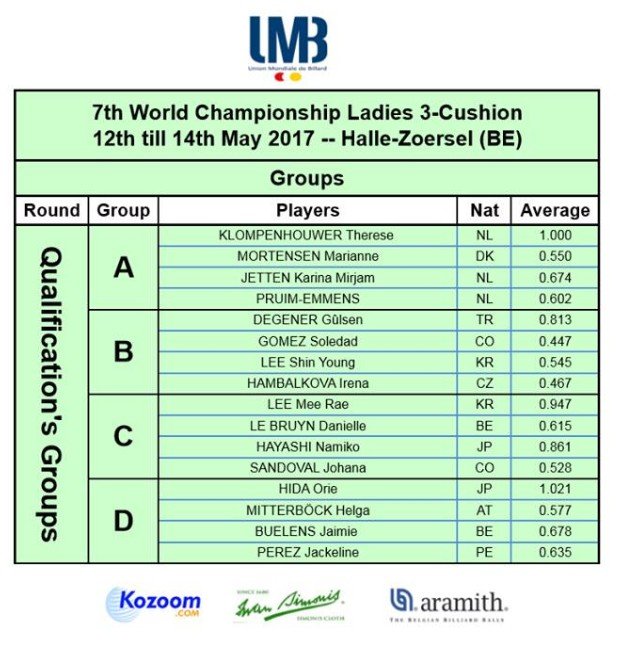From 12 - 14 May, Danielle Le Bruyn and her team will host the World Championship 3-cushion for women, in Biljartcentrum De Ploeg in Halle-Zoersel, Belgium. Defending champion Therese Klompenhouwer will be the number 1 seed, and the obvious favorite.
A quick look at the field will tell you that Gülsen Degener, Lee Mee Rae, and Orie Hida are the most dangerous opponents for Therese, with Namiko Hayashi and Karina Jetten as players who could come up with surprise wins .
We've seen Gülsen defeat seasoned campaigner Ronny Brants recently (in Luxor), and she made her 30 points in 32 innings in that match. That's above her usual pace, but it's a warning sign. Lee Mee Rae is best remembered for that thrilling final against Therese in the last WC, where she took the title holder from Nijkerk all the way to a shootout. She is young, and her average is on the rise. Orie Hida should never be underestimated; next to Therese, she is the only woman consistently around and above 1 average in the past 15 years.

The politically correct thing to write about women's 3-cushion is: they do so well considering they are amateurs with either jobs or kids, the atmosphere is great, their behavior is exemplary. I have no trouble putting that on paper. I just did.
What is a lot more difficult, is saying out loud that women's 3-cushion as a whole is not in great shape. If you do, those who work hard to promote it and some of the players will feel offended, belittled, attacked. You can't ever be critical of the averages played by the bottom half of the field: you will be crucified.
I've written about these problems before, and I'll give it another go. Not because I enjoy stepping on toes, but because I like to call it as I see it. And because few things would give me greater pleasure than to see women's 3-cushion blossom and grow.
Some of the things that are wrong with international ladies championships, are NOBODY'S FAULT. Billiards is a small economy as it is, and women's billiards generates maybe 1 % of the money flow in it. There is never a good budget, every tournament is a compromise.
There is very little the federations and confederations can do to improve the conditions for the players, in terms of prize money and travel expenses. That's one major bump in the road. Here's the second: invitations. The world ranking list for women is not an accurate instrument at all; it can't possibly be with so few tournaments being held. As a result, some of the better players are not even present when and where it matters: at the World Championships.
Examples? During the 2013 women's invitational in New York, Su Ah Park from Korea made a strong impression, finishing third behind TK and Hida. The 2012 world champion Natsumi Higashiuchi is not in this field. Neither is the talented Srong Pheavy from Cambodia (the only woman to have beaten Therese in the past four years), or Mercedes Gonzalez from the USA. For those last two, it could well be that they are not properly represented by a national federation and therefore not eligible for a WC. But all four I've just mentioned would have an excellent chance of reaching the quarterfinals or better. This is the equivalent of a men's World Championship without Dong Koong Kang, Merckx, Piedrabuena and Zanetti.
As I said, nobody's fault. But still, we have so few female players over 0.6, we should give the ones we have every chance to shine. If they can get some publicity, make a few dollars, even better. If playing against tough opponents makes them better, and they can inspire girls in their home countries to play the game: that's our pot of gold at the end of the rainbow.
My recommendation to the governing bodies would be, to have a very liberal wild card policy for confederational and world championships for women. Going strictly by the world ranking list is not wise here.
How do we grow and promote women's 3-cushion? From the grass roots, by scouting. Yes, it will be difficult to correctly identify those younger female players who are on 0.4, but with the potential to reach 0.8. If you can find them though, and teach them, they can do wonders for women's billiards. Therese has been (and is) a wonderful ambassador for the sport, but she could sure use a little help. And a bit more competition.
